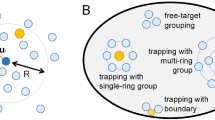Abstract
Target enclosure by autonomous robots is useful for many practical applications, for example, surveillance of disaster sites. Scalability is important for autonomous robots because a larger group is more robust against breakdown, accidents, and failure. However, it is more difficult to operate a larger group of robots because their individual capacity for recognizing team-mates should be higher. In this paper, to achieve a highly scalable target enclosure model, we demonstrate a new condition for Takayama’s enclosure model. The original model requires a static relationship between agents. However, robots can form an enclosure even under a dynamic topology on the basis of a nearest neighbor graph; hence, they do not require recognition capability. We confirm this by an analytical discussion of switched systems and a series of computer simulations.






Similar content being viewed by others
References
Takayama Y, Yamamoto S, Takimoto T (2008) Distributed formation control of a nonholonomic multi-agent system for target-enclosing operations. In: Proceedings of 9th SICE System Integration Division Annual Conference 2008, pp 679–680
Yamaguchi H (2003) A cooperative hunting behavior by nonholonomic mobile robot troops.Trans. Jpn Soc Mech Eng C 69(688):3285–3292
Kobayashi Y, Otsubo K, Hosoe S (2007) Autonomous decentralized control of capturing behavior by multiple mobile robots. Trans Soc Instrum Control Eng 43(8):663–671
Kim T, Sugie T (2007) Cooperative control for target capturing task based on a cyclic pursuit strategy. Automatica 43:1426–1431
Masubuchi I, Zhai G (2008) Control of hybrid systems-V: analysis and control of switched systems. Systems Control Inform 52(1):25–31
Marshall JA, Brouvke ME, Francis BA (2004) Formations of vehicles in cyclic pursuit. IEEE Trans Autom Control 49(11):1963–1974
Olfati-Saber R (2006) Flocking for multi-agent dynamic systems: algorithms and theory. IEEE Trans Autom Control 51(3):401–420
Olfati-Saber R, Fax JA, Murray RM (2007) Consensus and cooperation in networked multi-agent systems. Proc IEEE 95(1):215–233
Atlee Jackson E (1995) Perspectives of Nonlinear Dynamics 1. Cambridge University Press
Xu X, Zhai G (2005) Some results on practical asymptotic stabilizability of switched systems. In: 44th IEEE Conference on Decision and Control and European Control Conference 2005, CDC-ECC ’05, pp 3998–4003
Author information
Authors and Affiliations
Corresponding author
Additional information
This work was presented in part at the 17th International Symposium on Artificial Life and Robotics, Oita, Japan, January 19–21, 2012.
About this article
Cite this article
Kubo, M., Yoshimura, T., Yamaguchi, A. et al. Individual recognition-free target enclosure model. Artif Life Robotics 17, 11–16 (2012). https://doi.org/10.1007/s10015-012-0010-z
Received:
Accepted:
Published:
Issue Date:
DOI: https://doi.org/10.1007/s10015-012-0010-z




